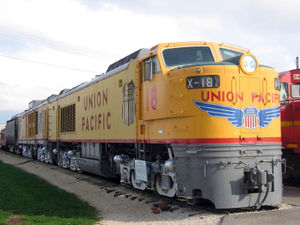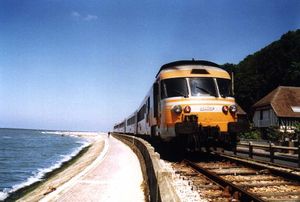Gas turbine-electric locomotive
2008/9 Schools Wikipedia Selection. Related subjects: Railway transport
A gas turbine-electric locomotive, or GTEL, is a locomotive that uses a gas turbine to drive an electric generator or alternator. The electric current thus produced is used to power traction motors. This type of locomotive was first experimented with in 1938 but reached its peak in the 1950s to 1960s. Few locomotives use this system today, although there has been some level of interest by Bombardier Transportation.
Description
In a GTEL a turbine engine, similar to a turboshaft engine, drives an output shaft that is in turn attached to an electrical generator via a system of gears. This in turn powers the traction motors. In overall terms the system is very similar to a conventional diesel-electric, with the large diesel engine replaced with a smaller gas turbine of similar power.
A gas turbine offers some advantages over a piston engine. There are few moving parts, decreasing the need for lubrication and potentially reducing maintenance costs, and the power-to-weight ratio is much higher. A turbine of a given power output is also physically smaller than an equally powerful piston engine, allowing a locomotive to be very powerful without being inordinately large. However, a turbine's power output and efficiency both drop dramatically with rotational speed, unlike a piston engine, which has a comparatively flat power curve. This makes GTEL systems useful primarily for long-distance high-speed runs.
Union Pacific operated the largest fleet of such locomotives of any railroad in the world, and was the only railroad to use them for hauling freight. Most other GTELs have been built for small passenger trains, and only a few have seen any real success in that role. After the oil crisis in the 1970s and the subsequent rise in fuel costs, gas turbine locomotives became uneconomical to operate, and many were taken out of service. Additionally, Union Pacific's locomotives required more maintenance than originally anticipated, due to fouling of the turbine blades by the Bunker C oil used as fuel. This type of locomotive is now rare.
History
Switzerland
Swiss Federal Railways agreed to test a gas turbine-electric locomotive Am 4/6 in 1939 and it was delivered in 1941/42. It was built by Brown Boveri with the unusual wheel arrangement of 1A-Bo-A1 and had a 2,200 horsepower (1.6 MW) turbine. This is one of the first applications of gas turbine technology of any sort; jet engines in England and Germany were first being started at about this time and would not enter squadron use until 1944.
United Kingdom
The Great Western Railway ordered two gas turbine-electric locomotives in the 1940s but these were not delivered until after nationalisation. They were numbered 18000 and 18100 by British Railways. Number 18000 was built in Switzerland with a Brown Boveri industrial gas turbine of 2,500 horsepower (1.9 MW). In contrast, number 18100 was built in Britain by Metropolitan Vickers and had an aircraft-type gas turbine of 3,000 horsepower (2.2 MW). Maximum speed, in both cases, was 90 miles per hour (145 km/h).
The British Rail APT-E, prototype of the failed Advanced Passenger Train, was turbine-powered. Like the French TGV, later models were electric instead. This choice was made because British Leyland, the turbine supplier, ceased production of the model used in the APT-E.
France
SNCF (French National Railways) used a number of gas-turbine trainsets, called the Turbotrain, in non- electrified territory. These typically consisted of a power car at each end with three cars between them. Turbotrain was in use up until 2005.
The first TGV prototype, TGV 001, was also powered by a gas turbine, but steep oil prices prompted the change to overhead electric lines for power delivery.
United States
Union Pacific ran a large fleet of turbine-powered freight locomotives starting in the 1950s. These were widely used on long-haul routes, and were economical due to their use of "leftover" fuels from the petroleum industry. At their height the railroad estimated that they powered about 10% of Union Pacific's freight trains, a much wider use than any other example of this class. As other uses were found for these heavier petroleum byproducts, notably for plastics, the cost of operating these units became uneconomical and they were retired from service by 1970.
In the 1960s United Aircraft built the Turbo passenger train, which was tested by the Pennsylvania Railroad and later used by Amtrak and VIA Rail. VIA's remained in service into the 1980s and had an excellent maintenance record during this period, but were eventually replaced by the LRC in 1982.
Amtrak purchased two different types of turbine-powered trainsets, which were both called Turboliners. The first set were similar in appearance to SNCF's Turbotrain, though compliance with FRA safety regulations made them heavier and slower than the French trains. None of the first set of Turboliners remain in service. Amtrak also added a number of similarly named Rohr Turboliners (or RTL) to its roster. A number of refurbished RTL IIIs are currently in service.
Canada
Canadian National Railways (CN) was one of the operators of the Turbo, which were passed on to VIA Rail. They operated on the major Toronto-Montreal route between 1968 and 1982, when they were replaced by the LRC.
In 2002, Bombardier Transportation announced the launch of the JetTrain, a high-speed trainset consisting of tilting carriages and a locomotive powered by a Pratt & Whitney turboshaft engine. No JetTrains have yet been sold for actual service.

